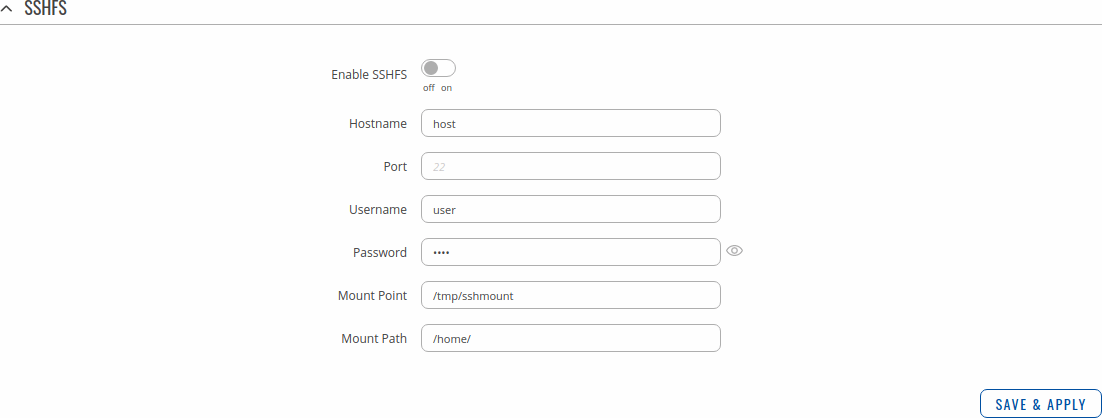Difference between revisions of "Template:Networking rutos manual sshfs"
From Teltonika Networks Wiki
Gytispieze (talk | contribs) m (Text replacement - "\{\{Template: Networking_rutos_manual_fw_disclosure (.*) (.*) (.*) (.*) \}\}" to "{{Template: Networking_device_manual_fw_disclosure | series = {{{series}}} | name = {{{name}}} | fw_version ={{Template: Networking_device_manual_latest_fw | series = {{{series}}} | name = {{{name}}} }} }}") |
(Created page with "{{Template: Networking_rutos_manual_fw_disclosure | fw_version = {{{series}}}_R_00.02.06 | series = {{{series}}} }} __TOC__ ==Summary== <b>SSHFS</b> . This page is an ov...") |
||
| (14 intermediate revisions by 4 users not shown) | |||
| Line 1: | Line 1: | ||
| − | {{Template: | + | {{Template: Networking_rutos_manual_fw_disclosure |
| − | | | + | | fw_version = {{{series}}}_R_00.02.06 |
| − | + | | series = {{{series}}} | |
| − | |||
| − | |||
| − | |||
| − | |||
}} | }} | ||
__TOC__ | __TOC__ | ||
==Summary== | ==Summary== | ||
| − | <b>SSHFS</b> | + | <b>SSHFS</b> . |
| − | |||
| − | This | + | This page is an overview of the SSHFS section of {{{name}}} devices. |
{{Template: Networking_rutos_manual_package_disclosure | {{Template: Networking_rutos_manual_package_disclosure | ||
| Line 25: | Line 20: | ||
<b>SSHFS</b> configuration consists of setting up authentication, port and mount information parameters. Below is an example oh the SSHFS configuration page. | <b>SSHFS</b> configuration consists of setting up authentication, port and mount information parameters. Below is an example oh the SSHFS configuration page. | ||
| − | [[File: | + | [[File:Networking_rutos_manual_sshfs.png|border|class=tlt-border]] |
<table class="nd-mantable"> | <table class="nd-mantable"> | ||
| Line 40: | Line 35: | ||
<tr> | <tr> | ||
<td>Hostname</td> | <td>Hostname</td> | ||
| − | <td>string; default: <b> | + | <td>string; default: <b>host</b></td> |
| − | <td> | + | <td>.</td> |
</tr> | </tr> | ||
<tr> | <tr> | ||
<td>Port</td> | <td>Port</td> | ||
| − | <td>integer [0..65535]; default: <b> | + | <td>integer [0..65535]; default: <b>22</b></td> |
| − | <td> | + | <td>.</td> |
</tr> | </tr> | ||
<tr> | <tr> | ||
<td>Username</td> | <td>Username</td> | ||
| − | <td>string; default: <b> | + | <td>string; default: <b>user</b></td> |
| − | <td> | + | <td>.</td> |
</tr> | </tr> | ||
<tr> | <tr> | ||
<td>Password</td> | <td>Password</td> | ||
| − | <td>string; default: <b> | + | <td>string; default: <b>pass</b></td> |
| − | <td> | + | <td>.</td> |
</tr> | </tr> | ||
<tr> | <tr> | ||
<td>Mount Point</td> | <td>Mount Point</td> | ||
| − | <td>filepath; default: <b>/sshmount</b></td> | + | <td>filepath; default: <b>/tmp/sshmount</b></td> |
| − | <td> | + | <td>.</td> |
| − | |||
</tr> | </tr> | ||
<tr> | <tr> | ||
<td>Mount Path</td> | <td>Mount Path</td> | ||
<td>filepath; default: <b>/home/</b></td> | <td>filepath; default: <b>/home/</b></td> | ||
| − | <td | + | <td>.</td> |
</tr> | </tr> | ||
</table> | </table> | ||
[[Category:{{{name}}} Services section]] | [[Category:{{{name}}} Services section]] | ||
Revision as of 16:16, 16 November 2020
Template:Networking rutos manual fw disclosure
Summary
SSHFS .
This page is an overview of the SSHFS section of {{{name}}} devices.
SSHFS is additional software that can be installed from the System → [[{{{name}}} Package Manager|Package Manager]] page.
SSHFS
SSHFS configuration consists of setting up authentication, port and mount information parameters. Below is an example oh the SSHFS configuration page.
| Field | Value | Description |
|---|---|---|
| Enable | off | on; default: off | Turns the SSHFS service on or off. |
| Hostname | string; default: host | . |
| Port | integer [0..65535]; default: 22 | . |
| Username | string; default: user | . |
| Password | string; default: pass | . |
| Mount Point | filepath; default: /tmp/sshmount | . |
| Mount Path | filepath; default: /home/ | . |
[[Category:{{{name}}} Services section]]
